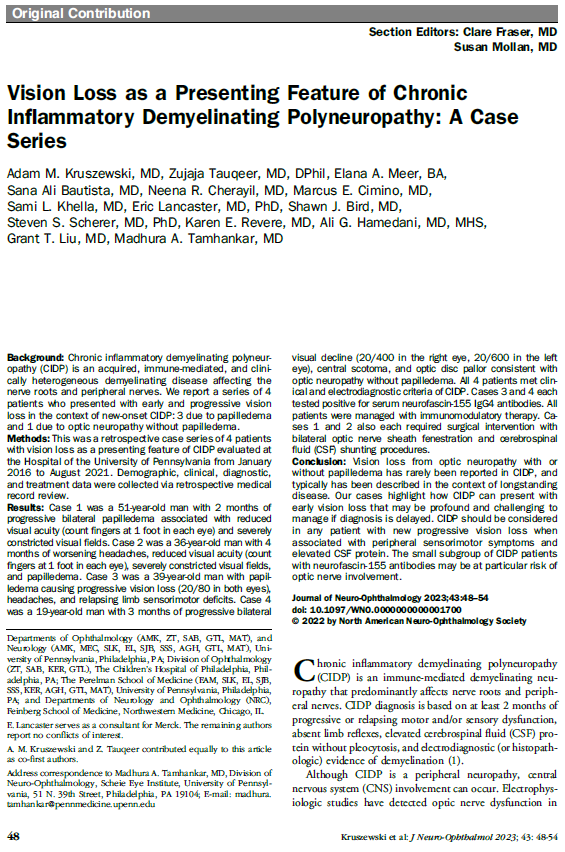Vision Loss as a Presenting Feature of Chronic Inflammatory Demyelinating Polyneuropathy: A Case Series
March 2023
Abstract
Background:
Chronic inflammatory demyelinating polyneuropathy (CIDP) is an acquired, immune-mediated, and clinically heterogeneous demyelinating disease affecting the nerve roots and peripheral nerves. We report a series of 4 patients who presented with early and progressive vision loss in the context of new-onset CIDP: 3 due to papilledema and 1 due to optic neuropathy without papilledema.
Methods:
This was a retrospective case series of 4 patients with vision loss as a presenting feature of CIDP evaluated at the Hospital of the University of Pennsylvania from January 2016 to August 2021. Demographic, clinical, diagnostic, and treatment data were collected via retrospective medical record review.
Results:
Case 1 was a 51-year-old man with 2 months of progressive bilateral papilledema associated with reduced visual acuity (count fingers at 1 foot in each eye) and severely constricted visual fields. Case 2 was a 36-year-old man with 4 months of worsening headaches, reduced visual acuity (count fingers at 1 foot in each eye), severely constricted visual fields, and papilledema. Case 3 was a 39-year-old man with papilledema causing progressive vision loss (20/80 in both eyes), headaches, and relapsing limb sensorimotor deficits. Case 4 was a 19-year-old man with 3 months of progressive bilateral visual decline (20/400 in the right eye, 20/600 in the left eye), central scotoma, and optic disc pallor consistent with optic neuropathy without papilledema. All 4 patients met clinical and electrodiagnostic criteria of CIDP. Cases 3 and 4 each tested positive for serum neurofascin-155 IgG4 antibodies. All patients were managed with immunomodulatory therapy. Cases 1 and 2 also each required surgical intervention with bilateral optic nerve sheath fenestration and cerebrospinal fluid (CSF) shunting procedures.
Conclusion:
Vision loss from optic neuropathy with or without papilledema has rarely been reported in CIDP, and typically has been described in the context of longstanding disease. Our cases highlight how CIDP can present with early vision loss that may be profound and challenging to manage if diagnosis is delayed. CIDP should be considered in any patient with new progressive vision loss when associated with peripheral sensorimotor symptoms and elevated CSF protein. The small subgroup of CIDP patients with neurofascin-155 antibodies may be at particular risk of optic nerve involvement.

